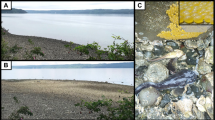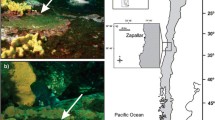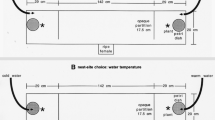Abstract
Nest site selection is a critical parental decision with profound fitness consequences, yet the physiological consequences of these decisions are rarely examined. Certain fishes and other aquatic organisms construct nests and provide parental care in the intertidal zone—an environment characterized by fluctuating water levels, which can exert intermittent and sometimes extreme abiotic stress on the animals that live there including dramatic changes in temperature and dissolved oxygen level. In this study, we used the plainfin midshipman fish, Porichthys notatus, to test whether (1) nest site preferences and reproductive success vary across an intertidal elevation gradient, and (2) fish that nest at higher elevations pay greater physiological costs due to prolonged exposure to more extreme abiotic conditions. We found that fish preferred nests lower in the intertidal zone, with larger males outcompeting smaller males for these sites. Broods at high elevations suffered greater offspring mortality than broods at lower elevations. The average microhabitat temperature of nests was also warmer and more variable at higher elevations compared to lower elevations. While isolated from the ocean during low tides, care-giving parents increased their use of anaerobic metabolism, and potentially draw upon oxygen reserves in the swim bladder. Our results suggest that the choice of nesting location can have profound effects on a parent’s physiology and may generate significant variation in reproductive success among individuals.




Similar content being viewed by others
References
Arora HL (1948) Observations on the habits and early life history of the batrachoid fish, Porichthys notatus Girard. Copeia 1948(2):89–93. https://doi.org/10.2307/1438409
Bass AH, Marchaterre MA (1989) Sound-generating (sonic) motor system in a teleost fish (Porichthys notatus): sexual polymorphism in the ultrastructure of myofibrils. J Comp Neurol 286(2):141–153. https://doi.org/10.1002/cne.902860202
Berg T, Steen JB (1965) Physiological mechanisms for aerial respiration in the eel. Comp Biochem Physiol 15(4):469–484. https://doi.org/10.1016/0010-406X(65)90147-7
Bergmeyer HU (1983) Methods of enzymatic analysis, 3rd edn. Academic Press, New York
Bermudes M, Ritar AJ (1999) Effects of temperature on the embryonic development of the striped trumpeter (Latris lineata Bloch and Schneider, 1801). Aquaculture 176(3–4):245–255. https://doi.org/10.1016/S0044-8486(99)00117-9
Bose AP, Cogliati KM, Howe HS, Balshine S (2014) Factors influencing cannibalism in the plainfin midshipman fish. Anim Behav 96:159–166. https://doi.org/10.1016/j.anbehav.2014.08.008
Bose AP, McClelland GB, Balshine S (2015) Cannibalism, competition, and costly care in the plainfin midshipman fish, Porichthys notatus. Behav Ecol 27(2):628–636. https://doi.org/10.1093/beheco/arv203
Bose AP, Kou HH, Balshine S (2016) Impacts of direct and indirect paternity cues on paternal care in a singing toadfish. Behav Ecol 27(5):1507–1514. https://doi.org/10.1093/beheco/arw075
Bose AP, Cogliati KM, Luymes N, Bass AH, Marchaterre MA, Sisneros JA, Bolker BM, Balshine S (2018) Phenotypic traits and resource quality as factors affecting male reproductive success in a toadfish. Behav Ecol 29(2):496–507. https://doi.org/10.1093/beheco/ary002
Bradford MM (1976) A rapid and sensitive method for the quantitation of microgram quantities of protein utilizing the principle of protein-dye binding. Anal Biochem 72(1–2):248–254. https://doi.org/10.1016/0003-2697(76)90527-3
Brantley RK, Bass AH (1994) Alternative male spawning tactics and acoustic signals in the plainfin midshipman fish Porichthys notatus Girard (Teleostei, Batrachoididae). Ethology 96(3):213–232. https://doi.org/10.1111/j.1439-0310.1994.tb01011.x
Cogliati KM, Neff BD, Balshine S (2013) High degree of paternity loss in a species with alternative reproductive tactics. Behav Ecol Sociobiol 67(3):399–408. https://doi.org/10.1007/s00265-012-1460-y
Cogliati KM, Danukarjanto C, Pereira AC, Lau MJ, Hassan A, Mistakidis AF, Bolker BM, Neff BD, Balshine S (2015) Diet and cannibalism in plainfin midshipman Porichthys notatus. J Fish Biol 86(4):1396–1415
Collette B, Acero A, Betancur R, Cotto A, Rojas P (2010) Porichthys notatus. The IUCN red list of threatened species. Version 2014.3. www.iucnredlist.org. Accessed 21 Nov 2018
Craig PM, Fitzpatrick JL, Walsh PJ, Wood CM, McClelland GB (2014) Coping with aquatic hypoxia: how the plainfin midshipman (Porichthys notatus) tolerates the intertidal zone. Environ Biol Fish 97(2):163–172. https://doi.org/10.1007/s10641-013-0137-3
Crane JM Jr (1981) Feeding and growth by the sessile larvae of the teleost Porichthys notatus. Copeia 1981:895–897. https://doi.org/10.2307/1444196
Davies R, Moyes CD (2007) Allometric scaling in centrarchid fish: origins of intra- and inter-specific variation in oxidative and glycolytic enzyme levels in muscle. J Exp Biol 210:3798–3804. https://doi.org/10.1242/jeb.003897
DeMartini EE (1988) Spawning success of the male plainfin midshipman. I. Influences of male body size and area of spawning site. J Exp Mar Biol Ecol 121(2):177–192. https://doi.org/10.1016/0022-0981(88)90254-7
DeMartini EE (1991) Spawning success of the male plainfin midshipman. II. Substratum as a limiting spatial resource. J Exp Mar Biol Ecol 146(2):235–251. https://doi.org/10.1016/0022-0981(91)90028-u
Dunn JF, Hochachka PW (1986) Metabolic responses of trout (Salmo gairdneri) to acute environmental hypoxia. J Exp Biol 123:229–242
Forstmeier W, Weiss I (2004) Adaptive plasticity in nest-site selection in response to changing predation risk. Oikos 104(3):487–499. https://doi.org/10.1111/j.0030-1299.1999.12698.x
Fretwell SD (1972) Populations in a seasonal environment (no. 5). Princeton University Press, Princeton
Kabacoff R (2011) R in action: data analysis and graphics with R. Manning Publications Co., Greenwich
LeMoine CM, Bucking C, Craig PM, Walsh PJ (2014) Divergent hypoxia tolerance in adult males and females of the plainfin midshipman (Porichthys notatus). Physiol Biochem Zool 87(2):325–333. https://doi.org/10.1086/674565
Lisser DF, Lister ZM, Pham-Ho PQ, Scott GR, Wilkie MP (2016) Relationship between oxidative stress and brain swelling in goldfish (Carassius auratus) exposed to high environmental ammonia. Am J Physiol Regul Integr Comp Physiol 312(1):R114–R124. https://doi.org/10.1152/ajpregu.00208.2016
Madsen T, Shine R (1999) Life history consequences of nest-site variation in tropical pythons (Liasis fuscus). Ecology 80(3):989–997. https://doi.org/10.1890/0012-9658(1999)080%5b0989:LHCONS%5d2.0.CO;2
Martin KL (1993) Aerial release of CO2 and respiratory exchange ratio in intertidal fishes out of water. Environ Biol Fish 37(2):189–196. https://doi.org/10.1007/BF00000594
Martin KL (2014) Theme and variations: amphibious air-breathing intertidal fishes. J Fish Biol 84:577–602. https://doi.org/10.1111/jfb.12270
Martin KL, Strathmann R (1999) Aquatic organisms, terrestrial eggs: early development at the water’s edge. Introduction to the symposium. Am Zool 39:215–217
Martin KL, Swiderski DL (2001) Beach spawning in fishes: phylogenetic tests of hypotheses. Am Zool 41(3):526–537. https://doi.org/10.1668/0003-1569(2001)041%5b0526:BSIFPT%5d2.0.CO;2
Martin KLM, Van Winkle RC, Drais J, Lakisic H (2004) Beach-spawning fishes, terrestrial eggs, and air breathing. Physiol Biochem Zool 77(5):750–759. https://doi.org/10.1086/421755
Mayer PM, Smith LM, Ford RG, Watterson DC, McCutchen MD, Ryan MR (2009) Nest construction by a ground-nesting bird represents a potential trade-off between egg crypticity and thermoregulation. Oecologia 159(4):893–901. https://doi.org/10.1007/s00442-008-1266-9
Nilsson GE, Östlund-Nilsson S (2008) Does size matter for hypoxia tolerance in fish? Biol Rev 83:173–189. https://doi.org/10.1111/j.1469-185X.2008.00038.x
Perry SF, Braun MH, Genz J, Vulesevic B, Taylor J, Grosell M, Gilmour KM (2010) Acid–base regulation in the plainfin midshipman (Porichthys notatus): an aglomerular marine teleost. J Comp Physiol B 180(8):1213–1225. https://doi.org/10.1007/s00360-010-0492-8
Pinheiro J, Bates D, DebRoy S, Sarkar D, R Core Team (2016) _nlme: Linear and nonlinear mixed effects models_. R package version, pp 3.1–128, http://CRAN.R-project.org/package=nlme
R Core Team (2016) R: a language and environment for statistical computing. R Foundation for Statistical Computing, Vienna. http://www.R-project.org/
Raffaelli D, Hawkins S (eds) (1996) Intertidal ecology. Chapman and Hall, London
Refsnider JM, Janzen FJ (2010) Putting eggs in one basket: ecological and evolutionary hypotheses for variation in oviposition-site choice. Annu Rev Ecol Evol Syst 41:39–57. https://doi.org/10.1146/annurev-ecolsys-102209-144712
Resetarits WJ Jr (1996) Oviposition site choice and life history evolution. Am Zool 36(2):205–215. https://doi.org/10.1093/icb/36.2.205
Richards JG (2009) Metabolic and molecular responses of fish to hypoxia. In: Richards JG, Farrell AP, Brauner CJ (eds) Fish physiology, vol 27. Academic Press, London, pp 443–485
Richards JG (2011) Physiological, behavioral and biochemical adaptations of intertidal fishes to hypoxia. J Exp Biol 214(2):191–199. https://doi.org/10.1242/jeb.047951
Sayer MDJ, Davenport J (1991) Amphibious fish: why do they leave water? Rev Fish Biol Fish 1(2):159–181
Scherle W (1970) A simple method for volumetry of organs in quantitative stereology. Mikroskopie 26(1):57–60
Smyder EA, Martin KLM (2002) Temperature effects on egg survival and hatching during the extended incubation period of California grunion, Leuresthes tenuis. Copeia 2:313–320. https://doi.org/10.1643/0045-8511(2002)002%5b0313:TEOESA%5d2.0.CO;2
Somero GN (2002) Thermal physiology and vertical zonation of intertidal animals: optima, limits, and costs of living. Integr Comp Biol 42(4):780–789. https://doi.org/10.1093/icb/42.4.780
Thomas S, Fievet B, Motais R (1986) Effect of deep hypoxia on acid-base balance in trout: role of ion transfer processes. Am J Physiol 250:R319–R327. https://doi.org/10.1152/ajpregu.1986.250.3.R319
Todd ES, Ebeling AW (1966) Aerial respiration in the longjaw mudsucker Gillichthys mirabilis (Teleostei: Gobiidae). Biol Bull 130(2):265–288. https://doi.org/10.2307/1539703
Tomanek L, Helmuth B (2002) Physiological ecology of rocky intertidal organisms: a synergy of concepts. Integr Comp Biol 42(4):771–775. https://doi.org/10.1093/icb/42.4.771
Truchot JP, Duhamel-Jouve A (1980) Oxygen and carbon dioxide in the marine intertidal environment: diurnal and tidal changes in rockpools. Resp Physiol 39(3):241–254. https://doi.org/10.1016/0034-5687(80)90056-0
Vornanen M, Asikainen J, Haverinen J (2011) Body mass dependence of glycogen stores in the anoxia-tolerant crucian carp (Carassius carassius L.). Naturwissenschaften 98:225–232. https://doi.org/10.1007/s00114-011-0764-5
Yamahira K (1997) Hatching success affects the timing of spawning by the intertidally spawning puffer Takifugu niphobles. Mar Ecol Prog Ser 155:239–248
Zuur AF, Ieno EN, Elphick CS (2010) A protocol for data exploration to avoid common statistical problems. Methods Ecol Evol 1(1):3–14. https://doi.org/10.1111/j.2041-210X.2009.00001.x
Acknowledgements
We are indebted to Chuck and Sally Flader as well as Eileen Carr and family for providing lodging and access to the field sites. We also thank J. Miller, N. Houpt, E. Sadler, N. Brown, M. Lapstra, K. Cogliati, and C. Hiltz for assistance with field work. This work was funded by Natural Sciences and Engineering Research Council of Canada grants to SB and GRS (Grant Nos. 222854-2011 and 418202-2012). Additional funding was provided to AB by the Department of Psychology, Neuroscience and Behaviour at McMaster University. Analyses reported in this article can be reproduced using the data provided in the Supplementary Materials.
Author contributions
AB, SB, BB, and GRS conceived and designed the study. AB and SB conducted the field work. BB conducted the laboratory assays. AB analyzed the data. AB and BB wrote the paper with input from all co-authors.
Author information
Authors and Affiliations
Corresponding author
Ethics declarations
Conflict of interest
No competing interests declared.
Additional information
Publisher's Note
Springer Nature remains neutral with regard to jurisdictional claims in published maps and institutional affiliations.
Aneesh P. H. Bose and Brittney G. Borowiec: Co-first authors.
Electronic supplementary material
Below is the link to the electronic supplementary material.
Rights and permissions
About this article
Cite this article
Bose, A.P.H., Borowiec, B.G., Scott, G.R. et al. Nesting on high: reproductive and physiological consequences of breeding across an intertidal gradient. Evol Ecol 33, 21–36 (2019). https://doi.org/10.1007/s10682-019-09970-7
Received:
Accepted:
Published:
Issue Date:
DOI: https://doi.org/10.1007/s10682-019-09970-7




